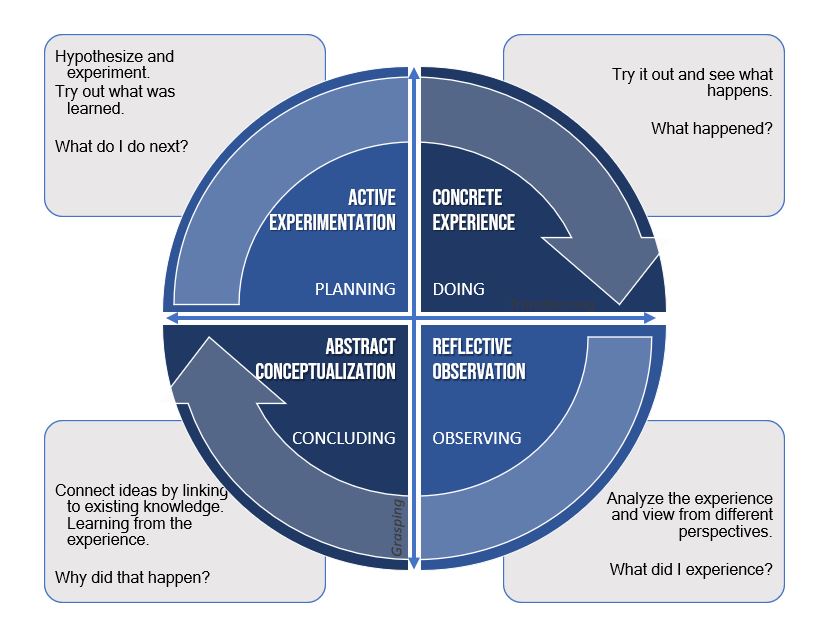What is Experiential Learning?
Experiential learning espouses engaging students “in direct experience and focused reflection to increase knowledge, develop skills, clarify values, and develop people’s capacity to contribute to their communities” (Association of Experiential Learning, n.d., para. 1). It is an approach to learning that emphasizes learning by doing (Kent State). The premise of this approach is learners can better master classroom concepts by connecting them to real-world experiences, such as engaging in community service, studying abroad, or conducting research (Kent State).
These experiences are aligned with course content and provide opportunities to apply knowledge and skills learned in the classroom. “Instruction is designed to engage students in direct experiences which are tied to real world problems and situations in which the instructor facilitates rather than directs student progress” (Northern Illinois University, n.d., para. 6).
Moreover, experiential learning provides the opportunity to build valuable work-related skills, such as working in teams. The approach involves the formation of a partnership between the learner and instructor and other students. When executed well, experiential learning can serve as a springboard to further learning opportunities (Association of Experiential Learning, n.d.).
 A
A
Brief History
The idea of experiential learning has been present in higher education for decades. Proponents of experiential learning include John Dewey, Carl Rogers, and David Kolb; these researchers advanced the notion that learning through direct engagement was more productive than traditional classroom learning experiences (Northern Illinois University, n.d.). In his 1938 book Education and Experience, John Dewey claims that real-world experience and education are closely interconnected (Northeastern University, n.d.). In Freedom to Learn (1969), Carl Rogers described two types of learning: cognitive (meaningless) and experiential (significant). Cognitive learning is academic, such as memorizing a poem, while experiential learning can be applied to real-world tasks (Instructionaldesign.org, n.d.). In 1984, David Kolb proposed his experiential learning theory (ELT), which describes a four-stage learning cycle incorporating action and reflection (Western Governors University, 2020).
Kolb’s Cycle of Experiential Learning
In Kolb’s model, learning occurs in a four-stage cycle “that begins with the learner having a concrete experience and ends with them actively experimenting with the knowledge they gained” (University of Florida, n.d., para. 2). Learners must go through the whole cycle for learning to occur because no single stage “is effective as a learning procedure on its own” (McCloud, 2017, para. 7). Kolb’s four stages are:
- Concrete experience – the learner engages in a new experience
- Reflective observation – the learner reflects on the experience
- Abstract conceptualization – the learner reaches a conclusion about the experience
- Active experimentation – the learner experiments with the new knowledge or skill
(University of Puget Sound, n.d., para. 1)
The Elements of Experiential Learning
The following elements are vital for effective experiential learning:
- Experiences must provide strong “learning potential.”
- Learners must participate in questioning, thinking critically, and solving problems; they are “challenged to take the initiative, make decisions and be accountable for results.”
- Students need to reflect on their experiences both during and after the event.
- Learners are fully engaged in the process, which “produces a perception that the learning task is authentic.”
- Experiences need to provide opportunities for the learners to develop and maintain relationships. (Boston University, n.d., para. 5)
Benefits of Experiential Learning
Experiential learning provides several benefits for learners. First, this approach affords opportunities for students to apply what they learn in class. Students also have the chance to practice working in teams, a valuable skill for life after college. In addition, experiential learning often elicits greater motivation from students, allowing them to reflect on their learning experiences. Finally, this approach provides practice for the real world and prepares students for their careers (Western Governors University, 2020).
Additional Resources
The Ten Commandments of Experiential Learning by Jay Roberts and Anna Welton, Inside Higher Ed, August 3, 2022. https://www.insidehighered.com/advice/2022/08/03/foundational-best-practices-experiential-learning-opinion
Designing Experiential Learning for Student Success by Sarah G. Brinegar, EAB, 2018. https://eab.com/wp-content/uploads/0001/01/EAB-Designing-Experiential-Learning.pdf
References
- Association of Experiential Learning. (n.d.) What is experiential learning? https://www.aee.org/what-is-experiential-education
- Kent State University. Community Engaged Learning. (n.d.). What is experiential learning and why is it important?
- https://www.kent.edu/community/what-experiential-learning-and-why-it-important#:~:text=Experiential%20Learning%20is%20the%20process,classroom%20to%20real%2Dworld%20situations.
- Boston University Center for Teaching and Learning. (n.d.). Experiential learning. https://www.bu.edu/ctl/guides/experiential-learning/
- Instructionaldesign.org. (n.d.)
- McCloud, S. (2017). Kolb’s learning styles and experiential learning cycle. SimplyPsychology.org. https://www.simplypsychology.org/learning-kolb.html
- Northeastern University Center for Advancing Teaching and Learning through Research. (n.d.). Introduction to experiential learning. https://learning.northeastern.edu/introduction-to-experiential-learning/
- University of Florida Center for Instructional Technology and Training. (n.d.). Kolb’s four stages of learning. https://citt.ufl.edu/resources/the-learning-process/types-of-learners/kolbs-four-stages-of-learning/
- The University of Puget Sound. (n.d.). Kolb’s learning cycle. https://www.pugetsound.edu/experiential-learning/available-resources/creating-critical-reflection-assignments-resource-1/kolbs
- Western Governors University. (2020, June 8). Experiential learning theory. https://www.wgu.edu/blog/experiential-learning-theory2006.html
